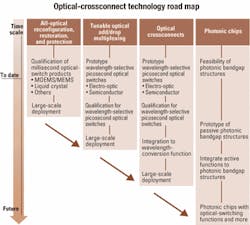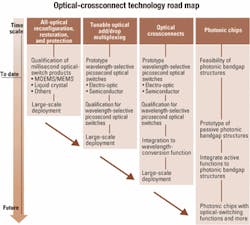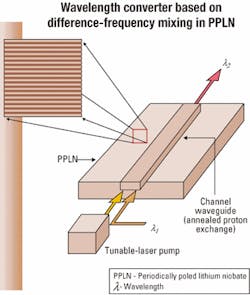All-optical wavelength conversion: the next challenge
Fast wavelength-tunable all-optical wavelength converters meet the demand for optical crossconnects in next-generation WDM networks.
JOCELYN LAUZON, INO Inc.
Optical crossconnects for DWDM communications are being developed based on currently available optical-switching technologies. These crossconnects, however, will only offer the full potential of DWDM optical networking when they integrate wavelength-conversion functionality. All-optical wavelength conversion, after optical switching, is the next major technological challenge to be tackled by the telecommunications industry. Several alternatives are under consideration, the most promising of which is difference-frequency mixing in periodically poled lithium niobate.
WDM optical communications was initially implemented to increase communications network capacity to meet the growing demand of consumers, driven predominately by the Internet. To further increase capacity, optical-electrical-optical (OEO) conversions along the transmission link need to be minimized, driving convergence toward all-optical networks. WDM is at the center of this convergence, since wavelength channels, instead of electronically encoded headers, perform necessary switching and routing in hubs along the communications network.
By using wavelength channels efficiently, switching and routing functions are performed without converting optical signals and are data-rate- and protocol-transparent. Some suggest that this approach be accomplished using passive optical components having fixed-wavelength channels for fixed communications connections. In most cases, however, passive optical networks (PONs) lack flexibility and do not use optical bandwidth efficiently enough, especially in the network periphery close to the end user.Switching signals at many wavelengths, among many points, create conflict when transmitters located at different points send signals to the same destination, at the same wavelength. The obvious solution is to shift optical channels to different wavelengths; hence, an interest in wavelength conversion arises from the growing need to manage multiple optical channels in complex optical networks. A wavelength converter takes an input optical signal at one wavelength and replicates it at a different wavelength. Ideally, conversion should be all-optical, require little power, not degrade the signal, and have a tunable output.1 Ultimately, an all-optical crossconnect would integrate the functions of optical switching and wavelength conversion.
The optical-crossconnect technology road map (see Figure 1) indicates that currently available optical switches with millisecond response times form a path that leads to all-optical reconfiguration, restoration, and protection. These functions are becoming available and justifiably creating a large amount of interest. Looking ahead, however, the move toward tunable optical add/drop multiplexers (OADMs) and optical crossconnects must be undertaken immediately to reach these goals in the not-too-distant future.
The optical crossconnects now under development should share a common capability-the ability to integrate. "Integration" means many things, such as miniaturization, built-in units, and multifunction attributes. Components should be small for scalability, power consumption, and space consumption, and should be easily adapted to an automated manufacturing process for obvious cost-reduction reasons. An automated manufacturing process is easily implemented if the fabrication of a component starts with a single substrate, building in features progressively through multiple successive treatments.
Integration also leads to adding different photonic functions on the same substrate, such as combining optical switching and wavelength conversion. Such integrated optical crossconnects should be based on a waveguide configuration, as waveguide crossconnects reliably stabilize a light path with respect to switching and wavelength-conversion elements and input/output ports, even during shock, vibration, and other environmental influences.2
Increasing integration should ultimately lead to the feasibility of photonic chips that become as popular as currently available electronic chips. Currently, the most promising path toward such photonic chips is through the development of photonic bandgap structure components.3
All-optical converters
Several alternatives are proposed as all-optical wavelength-converter components. Laser converters, for example, direct a strong input signal at one wavelength, into a continuous-wave single-frequency laser oscillating at another wavelength. The input causes gain saturation, draining light energy from the oscillation wavelength. This alternative has a few important drawbacks: The output signal at the laser wavelength is the inverse of the original input, requiring input power larger than 0 dBm, and its speed is limited by internal resonances of the laser to approximately 10 Gbits/sec.1
The most promising approach is to use a non-linear converter. Such wavelength converters are based on coherent non-linear processes in which two or more wavelengths interact to generate additional wavelengths. "Difference-frequency mixing converters" generate an output signal that is the difference-frequency between the pump light and input signal.
The success of this method depends heavily on the non-linear performance of the selected material. Some approaches use long lengths of fiber and other semiconductor amplifiers.1 However, the most convincing results are from an optical material well-known for its non-linear characteristics: lithium niobate (LiNbO3). This material offers good response time and signal-to-noise ratio.
Difference-frequency mixing
Figure 2 shows a schematic representation of a wavelength converter based on difference-frequency mixing in a lithium niobate substrate. The first signal is incident, and propagated within the device at a certain frequency or wavelength (λ1). The second signal is generated within the device from the incident signal and propagates in parallel to this incident signal at a second frequency or wavelength (λ2). Frequency generation is ensured by using a material with large second-order susceptibility (χ2), such as lithium niobate crystals. The phase-matching condition between the pump, incident signal, and generated signal is ensured by performing periodic modifications of the polarization of the material along the path of the incident signal.
Wavelength converters based on difference-frequency mixing in a PPLN show conversion efficiencies of more than 40% (4-dB conversion loss), and this efficiency value continues to improve, benefiting from channel waveguides imprinted in the lithium niobate crystal.5 The channel waveguides (see Figure 2), are imprinted in a lithium niobate crystal by an annealed proton exchange technique. Such waveguides ensure a large overlap between the three interacting signals and a high power density for all three signals, a key factor for any non-linear effect. The waveguides also improve power coupling with optical-fiber pigtails.
The configuration illustrated in Figure 2 should be adapted to minimize polarization-mode dispersion, which is not shown in the schematic.Optical crossconnects, in addition to having multiple tunable OADM functions, should have a wavelength-conversion function that allows full access to all the capacity offered by WDM optical communications systems. Thus, both all-optical-switching and wavelength-conversion functions should be part of optical crossconnects.
Lithium niobate also offers the possibility of creating a fast wavelength-selective optical-switching function on a monolithic planar waveguide substrate through its electro-optic characteristic.6 If a wavelength-selective fast optical switch is made from lithium niobate, it is easy to see how optical-switching and wavelength-conversion functions are integrated within a single component (see Figure 3). Figure 4 shows how such optical crossconnects can be used within a long-haul WDM optical communications network.
From long-haul to access
Optoelectronic wavelength converters are finding near-term applications, but fast, wavelength-tunable all-optical wavelength converters are needed to fulfill the demand for optical crossconnects in next-generation high-speed WDM networks. These components will not only serve long-haul systems but will also prove very useful in metro and even access networks, if designed properly.
Jocelyn Lauzon is director of the photonics and guided-wave optics sector of INO Inc. (Ste-Foy, Quebec) and can be reached at 418-657-7006 or [email protected]. She would like to thank the following INO colleagues for their fruitful discussions: Pierre-Yves Cortès, head of technology, optical communications; Chiara Meneghini, project leader, integrated optics; Georges Baldenberger, project leader, PPLN; and Claude Paré, project leader, numerical simulations. Francis Généreux, an INO scholar, has also contributed to the different schematics that are included in this article.
References
- J. Hecht, "All-optical converters promise improved networks," Laser Focus World, April 2001, pp. 159-164.
- M. Zdeblick, "Optical switches: Design variables prevent a single industry standard," Laser Focus World, March 2001, pp. 139-144.
- M.D.B. Charlton et al., "Guided mode analysis and fabrication of a 2-dimensional visible photonic bandgap structure confined with a planar semiconductor waveguide," Materials Science and Engineering B, 49, 1997, pp. 155-165.
- C. Paquet et al., "Method for the fabrication of patterned poled dielectric structures and devices," Canadian and U.S. patent filed on March 1, 2001, assignee INO.
- M.-S. Chou et al., "Optical frequency mixers for WDM and TDM applications," OFC 2000 post-deadline papers, FB1-1, March 2000, pp. 16-18.
- J. Lauzon et al., "Wavelength-selective functions enable tunable optical switches," WDM Solutions, June 2001, pp. 49-54.




